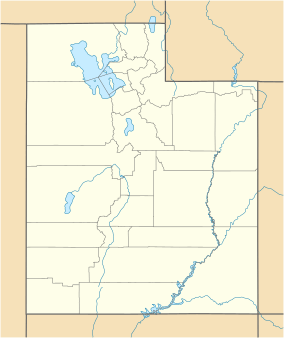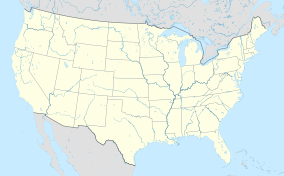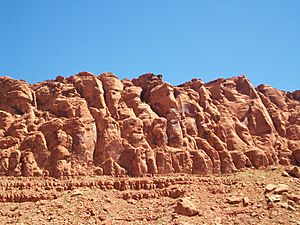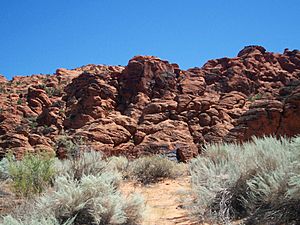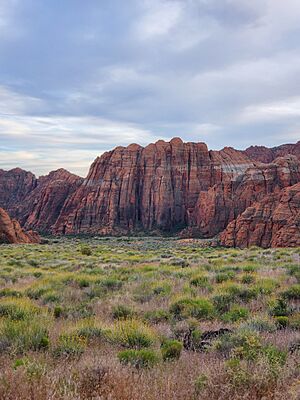Snow Canyon State Park facts for kids
Quick facts for kids Snow Canyon State Park |
|
|---|---|
|
IUCN Category V (Protected Landscape/Seascape)
|
|
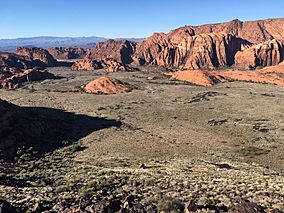
Snow Canyon State Park
|
|
| Location | Washington, Utah, United States |
| Area | 7,400 acres (30 km2) |
| Established | 1958 |
| Named for | Lorenzo and Erastus Snow |
| Visitors | 735,329 (in 2022) |
| Operator | Utah State Parks |
Snow Canyon State Park is a cool state park in Utah, USA. It's part of the Red Cliffs Desert Reserve. The park is famous for its amazing canyon, which was carved out of red and white Navajo sandstone rocks. You can also see old Santa Clara Volcano lava flows, lava tubes, and sand dunes here! Snow Canyon is close to the towns of Ivins and St. George in Washington County.
Contents
Exploring Snow Canyon Park
Snow Canyon State Park has many sandstone canyons. Two main canyons, West Canyon and Snow Canyon, meet in the middle of the park. From there, the canyon continues south. It eventually opens up near the town of Santa Clara.
A paved road goes through the park. It starts from Ivins in the south and winds up the canyon. Then, it climbs to a higher area and connects to State Route 18. The park also includes two cinder cones (small volcanoes) near Diamond Valley. The highest point in the park is a peak about 5,024 feet (1,531 meters) high.
Fun Things to Do in Snow Canyon
Snow Canyon State Park is open all year for outdoor fun! You can go hiking, mountain biking, and even horseback riding. The park has 17 campsites for tents and 14 spots for RVs.
- A day pass costs $10 for Utah residents.
- If you love hiking or biking, you can get a yearly pass for $100.
- The Johnson Canyon trail leads to a huge arch. You don't need to pay to use this trail. However, it's usually closed from April to September to protect wildlife.
Weather in Snow Canyon

Snow Canyon is in a special spot where three different desert areas meet: the Mojave Desert, Great Basin, and Colorado Plateau. Because it's a desert, it doesn't rain much, only about 7.5 inches (19 cm) per year. Summers can get very hot!
- In summer, the average low temperature is around 68°F (20°C). Highs can reach about 101°F (38°C).
- In winter, the average low temperature is around 30°F (-1°C). Highs are around 55°F (13°C).
History of Snow Canyon
People have been in Snow Canyon for a very long time, since the 5th century BC.
- From AD 200 to 1250, the Ancestral Puebloans lived nearby. They used the canyon for hunting and gathering food.
- The Southern Paiute people used the canyon from AD 1200 until the mid-1800s.
- Local stories say that Mormon pioneers found Snow Canyon in the 1850s while looking for lost cows.
Snow Canyon became a state park in 1958. It was one of the first parks added to Utah's state park system. The park grew over time with more land being added. It was first called Dixie State Park. Later, it was renamed after Lorenzo and Erastus Snow, who were important early leaders in Utah. The park officially opened to visitors in 1962.
Snow Canyon in Movies
Many Hollywood movies have filmed scenes in Snow Canyon! Its unique landscape makes it a great backdrop. Some famous movies filmed here include:
- The Conqueror (1956) with John Wayne
- Butch Cassidy and the Sundance Kid (1969)
- The Electric Horseman (1979)
- Jeremiah Johnson (1972)
- The Flintstones (1994)
- High School Musical 2 (2007)
Animals and Plants of Snow Canyon
Snow Canyon is home to many cool animals and plants that are adapted to the desert.
Animals in the Park
You might see different mammals like coyotes, kit foxes, antelope ground squirrels, and bobcats. Birds like greater roadrunners, common ravens, and Gambel's quail are also common. The park also has lizards, snakes, and amphibians, such as desert spiny lizards and canyon tree frogs.
Thirteen special species are protected by law in the park. These include amazing animals like peregrine falcons, desert tortoises, and gila monsters. You might even see small fences along the roads. These are there to help ground animals stay safe and off the roads.
Plants in the Park
The plants here are tough desert species. Some common ones are creosote, narrow-leaf yucca, pinyon pine, and different types of cactus like strawberry hedgehog cactus. If the weather is just right, you can see beautiful wildflowers blooming in the fall and spring.
Trails to Explore
Snow Canyon has many trails for different skill levels.
- Whiptail Trail - 6 miles (9.7 km). Easy. This paved trail is great for walking, jogging, biking, and rollerblading.
- Johnson Canyon - (Open November 15 to March 1 only) - 2 miles (3.2 km). Easy. This trail goes through lava flows and red rock to a 200-foot (61 m) arch.
- Jenny's Canyon - (Closed March 31 to June 1) - 0.5 miles (0.8 km). Easy. This short trail leads to a narrow, sculpted canyon.
- Sand Dunes - 0.5 miles (0.8 km). Easy. This trail leads to a big area of red sand, perfect for playing!
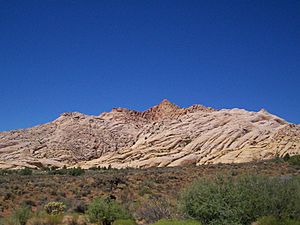
- West Canyon Road - 7 miles (11 km). Easy. This gravel and sand road follows along washes and tall cliffs.
- Pioneer Names - 0.5 miles (0.8 km). Easy. On this trail, you can see names written by pioneers way back in 1883!
- Hidden Pinyon - 1.5 miles (2.4 km). Moderate. This trail teaches you about the park's geology and plants.
- Three Ponds - 3.5 miles (5.6 km). Moderate. This trail goes through sandy areas to a canyon. Potholes in the sandstone collect rainwater, giving the trail its name.
- Petrified Dunes Trail - 1 mile (1.6 km). Moderate. This trail crosses huge sandstone areas that look like sand dunes frozen in time.
- Butterfly Trail - 2 miles (3.2 km). Moderate. This trail winds along the Petrified Dunes and leads to a viewpoint and lava tubes.
- White Rocks Trail/Lava Flow Overlook - 4 miles (6.4 km). Moderate. This trail goes through lava flows and leads to a natural amphitheater made of white sandstone. You can also reach the amphitheater on a 1-mile (1.6 km) trail from State Route 18.


